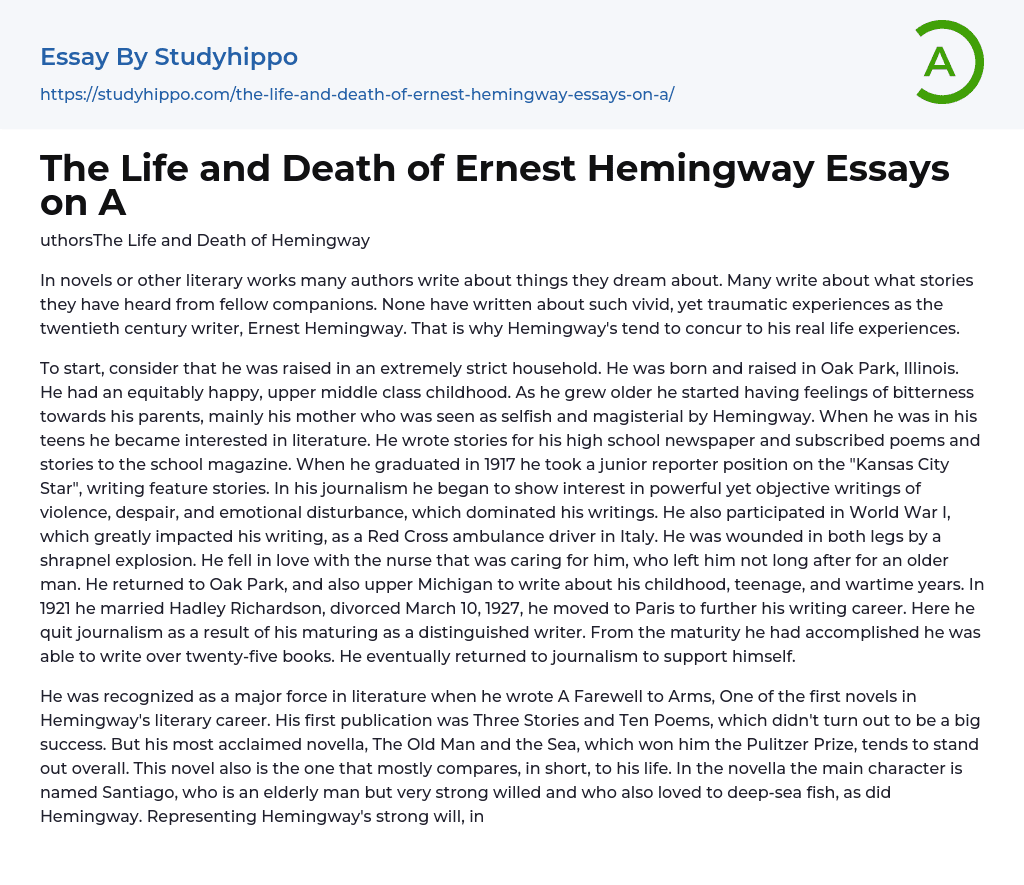Ernest Hemingway, a 20th-century writer, drew inspiration for his novels and literary works from various sources. Unlike many authors who rely on dreams or stories they have heard, Hemingway's writings were strongly influenced by his own real-life experiences. Growing up in Oak Park, Illinois in a strict household shaped his perspective and provided material for him to draw from. Despite having a generally happy childhood in a middle-class family, Hemingway harbored bitterness towards his parents, particularly his mother whom he viewed as selfish and authoritarian.
As an adolescent, he discovered his passion for literature and started writing stories for his high school newspaper. He also submitted poems and stories to the school magazine. After graduating in 1917, Hemingway began working as a junior reporter at the "Kansas City Star." This job allowed him to write featu
...re stories that reflected his fascination with powerful and objective depictions of violence, despair, and emotional turmoil – themes that would later become prominent in his writing.
Hemingway's involvement in World War I played a significant role in shaping his writing style as well. Serving as a Red Cross ambulance driver in Italy, he sustained injuries from shrapnel explosions which affected both of his legs.During this time, Hemingway fell in love with a nurse who cared for him but was ultimately abandoned by her for an older man. His comprehension of human suffering deepened due to traumatic experiences, which had a profound impact on the emotional intensity in much of his writing. He went back to Oak Park and upper Michigan to write about his childhood, teenage years, and wartime encounters. In 1921, Hemingway married Hadley Richardson but they ended their marriage
on March 10, 1927. After their separation, he relocated to Paris to further his writing career and left journalism behind as he gained recognition as an esteemed writer. Thanks to his accomplished maturity, he was able to author over twenty-five books and eventually returned to journalism for financial support. A significant milestone in his literary journey came with the publication of A Farewell to Arms, one of his early novels. While Three Stories and Ten Poems, his initial publication, did not achieve much success, The Old Man and the Sea stands out prominently in Hemingway's body of work as it earned him the Pulitzer Prize. This novella also reflects elements from Hemingway's own life as its protagonist Santiago shares similarities with Hemingway himself - both are elderly men with strong determination and a passion for deep-sea fishing.Santiago, the protagonist of "The Old Man and the Sea," is depicted as a heavy drinker, much like Hemingway himself, who persevered through three marriages and World War I along with other conflicts. In the novella, Santiago's deep affection for Manolin, a brave young Cuban boy, mirrors the love that Hemingway's oldest child had for his father. Despite his wealth, Santiago lives in a small shack by the shore and faces scarcity in both food and money just like Hemingway. Santiago's skill in battling fish reflects Hemingway's expertise and reputation in fist fighting. The fish caught by Santiago symbolize Hemingway's tumultuous love life which included multiple divorces, numerous wives, and the tragic death of one former wife. Similarly, the sharks slowly consuming the Marlin that Santiago worked tirelessly to catch represent how Hemingway's personal troubles gradually eroded his happiness.
Furthermore, Santiago's extensive ocean travels parallel Hemingway's insatiable wanderlust that took him from Spain and Italy to Cuba and Africa before settling in Cuba where "The Old Man and the Sea" takes place.In both the story and real life, Santiago/Hemingway often felt defeated by nature's elements such as fish and sharks, as well as his own personal struggles. Tragically, on July 2nd 1961 in Ketchum Idaho, Ernest Hemingway chose to end his life using a double barrel shotgun aimed at his head—a method reminiscent of what his father had done with a pistol. Recent events had taken a toll on him as he underwent shock therapy due to his claims of being monitored by the FBI, which he couldn't prove to convince others. The FBI's scrutiny stemmed from Hemingway's residence in Cuba during Fidel Castro's rise to power. The shock treatments weakened him mentally, leaving him vulnerable to despair. This vulnerability and Hemingway's inability to write are believed to be connected, along with his collaboration with suicide. In 1951, Hemingway experienced another loss when his mother Grace passed away. These factors, among others, could have contributed to his suicide and the overwhelming feeling he had towards his own life.
Works Cited: Hemingway, Ernest.The Old Man and the Sea.1952.New York: Simon and Schuster Inc., 1995.
- Book Summary essays
- Metaphor essays
- Reader essays
- Rhyme essays
- Literary devices essays
- Villain essays
- Books essays
- Genre essays
- Literary Criticism essays
- Writer essays
- Protagonist essays
- Simile essays
- Poem essays
- Book Report essays
- Book Review essays
- Greek Mythology essays
- Plot essays
- Tragic Hero essays
- Coming of Age essays
- Play essays
- Rhetoric essays
- Rhetorical Question essays
- Translation essays
- Understanding essays
- Reason essays
- Character essays
- Letter essays
- American Literature essays
- Literature Review essays
- Utopia essays
- Poetry Analysis essays
- Dante's Inferno essays
- Between The World and Me essays
- Incidents in The Life of a Slave Girl essays
- Flowers for Algernon essays
- Myth essays
- Everyday Use essays
- Boo Radley essays
- Genesis essays
- Richard iii essays
- Alice in Wonderland essays
- On the road essays
- Ozymandias essays
- The Nightingale essays
- Holden Caulfield essays
- Animal Farm essays
- 1984 essays
- A Hanging essays
- Shooting An Elephant essays
- A Tale Of Two Cities essays




